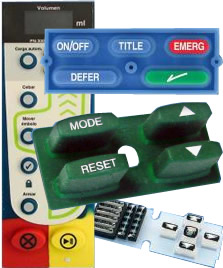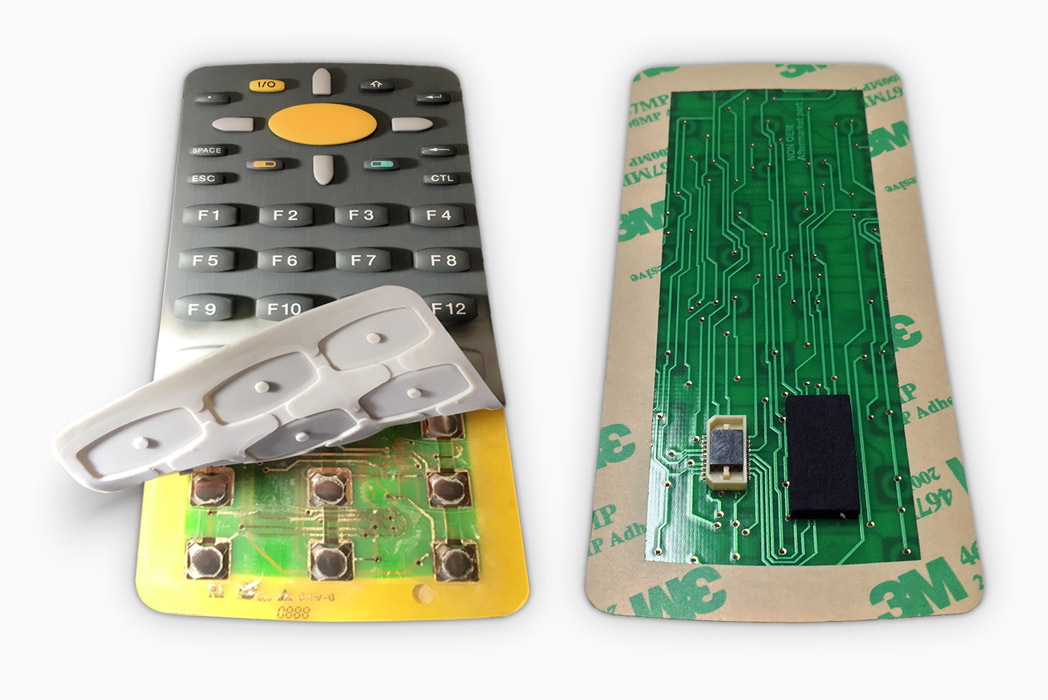The role of prototyping in designing Rubber Keypads for volume output
Uncovering the Diverse Enters and utilizes of Rubber Keypads in the Modern Technology Landscape Today
Rubber keypads have actually developed themselves as crucial elements in different technological applications. Their versatility makes them appropriate for consumer electronic devices, commercial machines, and clinical gadgets. As these keypads proceed to develop, brand-new modification alternatives and layout trends arise. This prompts a more detailed assessment of their advantages and making procedures. Recognizing these elements might reveal why rubber keypads stay a favored option in the modern technology landscape. What exists ahead for this functional element?
Introduction of Rubber Keypads
Rubber keypads function as a fundamental component in numerous electronic tools, using a tactile user interface for user communication. These keypads are typically made from silicone or rubber products, which provide flexibility and longevity. Their design commonly includes elevated icons or letters, boosting usability by permitting customers to feel the tricks - Rubber Keypads. Rubber keypads are resistant to dirt, moisture, and put on, making them suitable for requiring environments
In addition, they can be personalized pertaining to dimension, color, and shape, permitting makers to create special interfaces customized to certain items. The manufacturing procedure frequently involves techniques such as molding and printing, guaranteeing top quality result. Because of this, rubber keypads not only enhance functionality yet also contribute to the total aesthetics of the tool. With these qualities, rubber keypads continue to be a prominent option for both suppliers and consumers, highlighting their importance in the innovation landscape.
Usual Applications in Consumer Electronics
While several electronic tools rely upon touchscreens for customer communication, rubber keypads remain to play an essential duty in consumer electronic devices. These keypads are commonly made use of in devices such as push-button controls, gaming controllers, and house home appliances, where tactile comments improves user experience. Their sturdiness and resistance to use make them excellent for tools frequently based on heavy use.
Rubber keypads are likewise popular in mobile gizmos and mobile phones, where compact styles require responsive and trustworthy input techniques. The ability to customize the shape and texture of rubber keypads permits suppliers to create unique layouts that attract consumers. In addition, the soft touch of rubber offers convenience throughout long term usage, making these keypads a preferred selection for tools needing extended communication. Overall, rubber keypads continue to be a crucial component in the customer electronic devices landscape, combining functionality with user-friendly functions.
Role in Industrial and Medical Equipment
Rubber keypads play a necessary role in both industrial and medical devices, offering resilience and reliability sought after atmospheres. In industrial settings, they are commonly utilized in control panels and equipment, improving driver interaction with complicated systems. Similarly, in the medical field, rubber keypads promote user-friendly interfaces for tools that need precision and health.
Industrial Tools Applications
Keypads play an important function in the performance and user experience of commercial and clinical devices. In commercial settings, rubber keypads give a durable interface for machinery and control systems, enabling operators to conveniently input commands and adjust setups. Their resistance to dirt, dampness, and chemicals guarantees dependability under harsh problems normal of manufacturing facilities and making plants. Additionally, the responsive responses provided by rubber keypads boosts user communication, decreasing the probability of input errors. In addition to typical machinery, these keypads are important in automated systems and robotics, where precision is vital. The convenience of rubber keypads in various industrial applications underscores their significance in improving operational efficiency and guaranteeing safety in complex settings.
Medical Gadget Assimilation
As clinical devices significantly require straightforward user interfaces, the assimilation of rubber keypads has actually become vital in making sure efficient communication in between healthcare experts and devices. These keypads offer responsive comments, facilitating intuitive procedure even in high-pressure atmospheres. Their durability and resistance to severe cleaning representatives make them perfect for clinical settings, where hygiene and durability are vital. Additionally, rubber keypads can be tailored to consist of numerous forms, sizes, and shades, improving aesthetic recognition and ease of access for customers. This versatility permits the creation of specialized controls tailored to certain medical features, enhancing total performance. The duty of rubber keypads in clinical tool assimilation not only boosts functionality yet also promotes individual security and operational reliability in medical care settings.
Personalization Options and Layout Trends
Recent design trends emphasize minimalism and comfort designs, focusing on customer comfort and user-friendly interaction. Customized logos go to these guys and branding can be incorporated right into keypads, permitting business to maintain a natural brand name identification across their items. browse around this site Furthermore, improvements in making techniques, such as silicone molding, have made it easier to attain detailed designs and personalized designs.
Benefits of Rubber Keypads Over Various Other Types

Rubber keypads are additionally known for their toughness and resistance to environmental factors. They can endure temperature level, dust, and dampness fluctuations, making them excellent for industrial or outside setups. In addition, rubber keypads are commonly quieter than their plastic or metal equivalents, minimizing sound air pollution in common environments.
Additionally, the cost-effectiveness of rubber keypads makes them an eye-catching option for producers. Their lightweight nature adds to decrease shipping costs, while their customizable styles deal with particular branding needs. Generally, rubber keypads represent a reputable and flexible solution in the innovation landscape.
Production Techniques for High Quality and Sturdiness
In the production of rubber keypads, the option of appropriate products and molding processes plays an essential role in determining overall top quality and sturdiness. Different molding strategies, such as compression and injection molding, significantly influence the end product's efficiency. Recognizing these factors is essential for achieving suitable cause rubber keypad manufacturing.
Molding Processes Explained
A range of molding processes play an important role in the production of rubber keypads, guaranteeing both quality and durability. The most common techniques include compression molding, transfer molding, and injection molding. Compression molding includes placing rubber in a heated mold, where heat and pressure shape it into the desired kind. Transfer molding allows for more specific control over product flow and is ideal for complex layouts (Rubber Keypads). Shot molding, known for its rate and efficiency, injects liquified rubber right into a mold and mildew under high stress, creating high-volume components with regular high quality. Each approach offers unique benefits, affecting variables such as manufacturing design, cost, and rate flexibility, eventually influencing the efficiency and lifespan of rubber keypads in different applications
Product Selection Significance
Material option plays an essential role in the production of rubber keypads, straight affecting their efficiency and resilience. The option of rubber compounds, such as silicone or polyurethane, influences responsive feedback, resistance to use, and environmental toughness. High-grade materials guarantee that keypads can stand up to comprehensive use, preserving their capability gradually. Furthermore, the solution of rubber affects its resistance to temperature level fluctuations and exposure to chemicals, which are critical for tools in different settings. Employing advanced manufacturing methods, such as Extra resources compression or shot molding, more boosts the architectural stability of keypads. Eventually, careful product selection and manufacturing processes add considerably to the general quality, long life, and individual complete satisfaction of rubber keypads in today's innovation landscape.
Future Trends in Rubber Keypad Innovation
As technology remains to evolve, the future of rubber keypad development shows up appealing, with improvements poised to boost performance and user experience. One remarkable trend is the assimilation of touch-sensitive innovation, allowing capacitive comments that mimics the feel of traditional buttons while providing enhanced responsiveness. Additionally, the development of antimicrobial materials is likely to get traction, addressing health problems in shared and public gadgets.
Additionally, modification options are anticipated to expand, enabling users to customize vital designs and responsive responses, thereby dealing with diverse needs. The unification of smart modern technology, such as connection features, might additionally arise, permitting rubber keypads to communicate with various other devices effortlessly. As manufacturers concentrate on sustainability, green materials are anticipated to become more widespread, lining up with worldwide environmental goals. Generally, these fads promise to transform rubber keypads, making them more functional, user-friendly, and ecologically mindful in the innovation landscape.
Regularly Asked Concerns
How Do Rubber Keypads Compare in Cost to Various Other Keypad Types?
Rubber keypads usually use an affordable option contrasted to other keypad kinds, such as membrane or mechanical options. Their reduced production expenses and longevity make them an eye-catching selection for numerous applications in modern technology.
What Are the Ecological Influences of Rubber Keypad Production?

The ecological influences of rubber keypad manufacturing consist of source exhaustion, power intake, and air pollution from producing processes. In addition, improper disposal can cause plastic waste, contributing to ecological deterioration and hurting ecological communities otherwise managed sensibly.
Can Rubber Keypads Be Made Use Of Outdoors?
Rubber keypads can be utilized outdoors because of their sturdiness and resistance to weather elements. Their long life may depend on the quality of products made use of and the certain ecological problems they are exposed to.
What Maintenance Is Needed for Rubber Keypads?
Rubber keypads need normal cleaning to remove dirt and debris, periodic inspection for deterioration, and protection from extreme temperatures. Making sure proper storage space problems can extend their life expectancy and keep functionality with time.
Just How Do Rubber Keypads Perform in Extreme Temperatures?
Rubber keypads typically keep functionality in extreme temperature levels, displaying durability to both cold and heat. Nonetheless, long term direct exposure may cause product destruction, impacting their tactile action and general performance in extreme settings.
Rubber keypads offer as a basic element in different electronic devices, using a tactile user interface for user interaction. While numerous digital tools count on touchscreens for customer communication, rubber keypads continue to play a vital duty in customer electronics. Furthermore, the soft touch of rubber gives comfort during long term usage, making these keypads a favored selection for devices requiring extensive communication. Despite the expanding range of keypad products available, rubber keypads provide distinct benefits that make them a preferred choice in several applications. Rubber keypads generally offer a cost-efficient service compared to various other keypad types, such as membrane layer or mechanical alternatives.